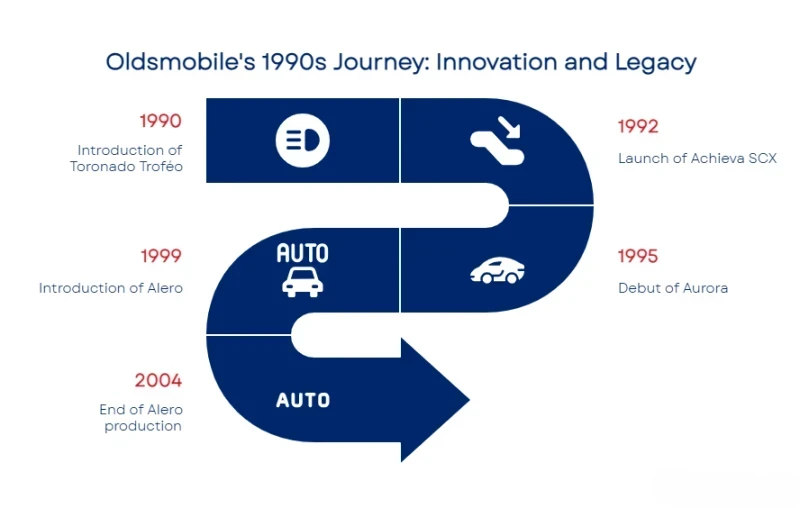How Oldsmobile Quietly Built Its Final Classics
1990s Oldsmobile cars were stylish and reliable, and now, some of them are turning into unexpected collector favorites. If you think Oldsmobile only made boring family sedans back then, you're not alone. Some of these cars—especially rare ones like the Achieva SCX or the Troféo—are experiencing a second life. Quietly, their values are ticking up, and collectors are starting to grab them while they’re still affordable.
What You’ll Learn
Which Oldsmobile models from the 1990s are now considered hidden gems
What made these cars so reliable and budget-friendly
How Oldsmobile’s bold design and tech moves gave it a surprising final chapter
Summary
1990s Oldsmobile cars combined reliability with bold design, offering a surprising mix of performance and innovation. Whether you’re into vintage sedans, sport coupes, or budget-friendly classics, Oldsmobile had a model that delivered on comfort, style, and longevity. Here's a more detailed breakdown:
Popular Models
Aurora: Upscale, V8-powered sedan with sleek lines and early tech features like navigation.
Toronado Troféo: A sporty, futuristic luxury coupe that stood out for its digital dash.
Achieva SCX: High-output performance coupe with racing roots, now a rare collector gem.
Alero: Affordable compact that closed out the Oldsmobile era with style.
Cutlass Supreme/Ciera: Boxy, reliable, and easy to maintain, making it great for daily driving or restoring.
Why People Still Buy Them
Reliable Engines: Especially models with the 3800 V6, known for lasting over 200,000 miles.
Affordable Entry: Many are still under $5,000 in good shape.
Collectible Growth: Limited-edition models are gaining interest in car forums and auctions.
Tips for Owners and Buyers
Use top-load transport to protect rare trims during shipment.
Learn how to ship a car across the country without risking damage or rust.
Compare trims and pricing in this top 10 affordable classic cars guide before buying.
Why the 1990s Mattered for Oldsmobile
The 1990s marked the last major effort for Oldsmobile to prove it still had a place in people’s garages. In the mid-1980s, Oldsmobile was moving over a million cars a year. By 1993? Sales had dropped to around 400,000. The problem wasn’t quality, it was fierce competition.
Oldsmobile had to stand out not just from Ford or Dodge, but also from its GM siblings, such as Buick and Chevrolet. With the arrival of luxury imports like Lexus and Acura, things got tough.
So Oldsmobile pivoted. Instead of playing it safe, they pushed modern styling, added upscale touches, and leaned into the slogan “not your father’s Oldsmobile.” This decade became their chance to stay relevant, and they made the most of it.
Models That Defined the Decade
Throughout the 1990s, Oldsmobile was in a transitional period. As General Motors sought to reposition the brand to attract younger buyers while retaining loyal customers, several key models emerged that shaped Oldsmobile's identity during this era.
Oldsmobile Aurora
Redefining Oldsmobile’s Image in the Luxury Segment
Introduced for the 1995 model year, the Oldsmobile Aurora was developed as the flagship sedan intended to lead a brand-wide revitalization. It was based on the Cadillac-derived G platform and featured advanced technology, a premium interior, and a design unlike any previous Oldsmobile. The Aurora represented a significant departure from the company's older styling cues and marked a turning point in the brand’s direction.
Key Features and Significance:
Powered by a 4.0L DOHC V8 engine derived from Cadillac’s Northstar series
Included an early in-dash navigation system and electronically controlled climate functions
Introduced a new design language that influenced future Oldsmobile vehicles, including the Intrigue and Alero
Removed the traditional Oldsmobile nameplate on the exterior, signaling a shift toward a more upscale identity
The Aurora was not only important for its engineering but also for its role in reshaping how consumers viewed the Oldsmobile brand.
Oldsmobile Toronado Troféo
A Technological Showcase in the Final Years of the Toronado
The Oldsmobile Toronado Troféo, produced during the late 1980s and early 1990s, marked the final iteration of the long-running Toronado nameplate. As front-wheel-drive personal luxury coupes began to lose popularity, Oldsmobile responded by positioning the Troféo as a tech-forward, driver-oriented vehicle.
Key Features and Significance:
Featured a sleek, aerodynamic coupe design with pop-up headlamps and integrated rear lighting
Offered one of the earliest touch-screen vehicle interfaces with the Visual Information Center (VIC)
Equipped with a digital dashboard, electronic climate control, and a heads-up display in later models
Tuned suspension and steering enhancements aimed at improving handling and driver engagement
The Troféo was a bold attempt to bring futuristic features to a domestic coupe platform and remains notable for its early adoption of infotainment technology.
Oldsmobile Achieva SCX
A Limited-Production Performance Model with Racing Roots
The Achieva SCX was a high-performance version of the compact Achieva, produced in limited numbers between 1992 and 1993. Designed to showcase Oldsmobile's engineering capabilities, the SCX drew inspiration from the brand’s success in SCCA racing, where the Quad 4 engine gained a reputation for power and reliability.
Key Features and Significance:
Powered by the W41 version of the Quad 4 HO engine, delivering 190 horsepower
Included performance upgrades such as a 5-speed manual transmission, stiffer suspension, and four-wheel disc brakes
Built in limited quantities, with approximately 1,000 units produced
Qualified as a factory-built homologation model for SCCA competition
Though short-lived, the SCX played a key role in reinforcing Oldsmobile’s performance credentials during a time when domestic sport compacts were gaining attention.
Oldsmobile Alero
A Strategic Move Toward Younger Buyers
Launched in 1999, the Alero was developed to replace both the Cutlass and Achieva models. It was part of Oldsmobile’s effort to modernize the lineup and appeal to younger buyers. Built on the GM N-body platform, the Alero shared architecture with the Pontiac Grand Am but offered more refined styling and a slightly more upscale interior.
Key Features and Significance:
Available in both sedan and coupe body styles, appealing to a wide audience
Offered two engine choices: a 2.4L inline-four and a 3.4L V6, paired with either manual or automatic transmissions
Included modern amenities such as ABS, traction control, and keyless entry in higher trims
Designed with a contemporary exterior and soft-touch interior materials
The Alero was one of the last new models Oldsmobile released before the brand’s closure was announced in 2000. It represented the company’s final push to remain competitive in the compact car segment.
Oldsmobile Cutlass Supreme and Cutlass Ciera
Mainstay Models Known for Reliability and Practicality
The Cutlass Supreme and Cutlass Ciera were long-standing models that served as core offerings throughout the 1980s and into the 1990s. While they did not introduce groundbreaking innovation, they offered consistent performance, comfort, and reliability, maintaining strong sales among traditional buyers.
Key Features and Significance:
The Cutlass Supreme was available in coupe, sedan, and convertible formats with V6 and V8 options
The Cutlass Ciera, built on the A-body platform, prioritized simplicity, fuel efficiency, and value
Both models were known for their durability, particularly the 3.1L V6 and 4T60 automatic transmission
Attracted repeat buyers and remained popular in fleet and family use through the decade
These vehicles played a stabilizing role for Oldsmobile during a time of experimentation and rebranding, providing a dependable choice for customers resistant to change.















